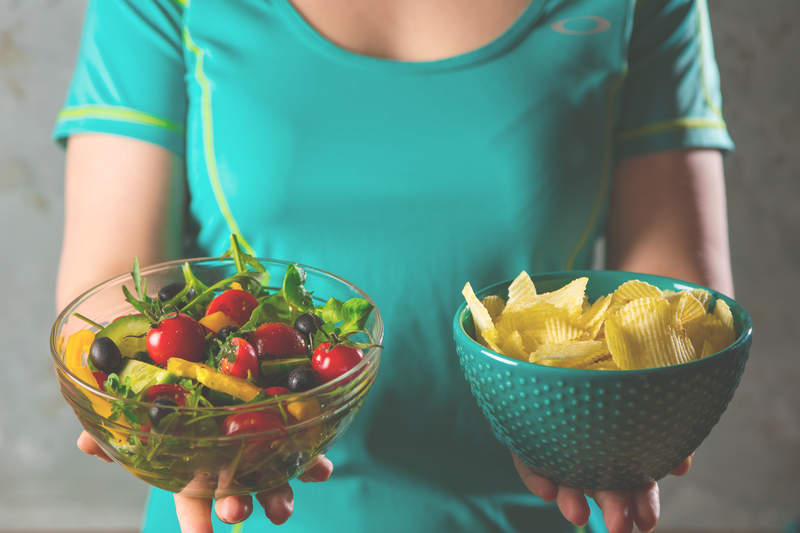What Is the 80/20 Rule Diet? And Does It Work?

Let’s be honest: when it’s time to make a change to lose weight or improve overall health, it can get overwhelming. Whether you’re counting calories, cutting carbs, or giving up junk food, you may even find your brain (and body) begins to rebel from day one. Perfection is, well, impossible. Fortunately, no matter what your goal, you don’t need to be perfect: you need balance. And that’s what the 80/20 diet is all about.
No matter which healthy diet plan you follow (and there are many), can you imagine following that plan perfectly forever? What about birthday parties, vacations, anniversaries, or just when you want to eat something for the pleasure of it (say, carbs or sweets)?
We know all-or-nothing, extreme thinking can lead down a dangerous path. All of us “slip up.” And the more strict we try to be, the more likely we are to fall hard when we do slip. After all, the goal isn’t to lose the weight, gain it back, lose it again… over and over again. Or get in shape to only get out of shape and then go for it again. Or to improve energy levels and feel fantastic, only to go back to dragging through the day again and then have to begin again.
The goal is to reach a healthy weight and maintain (or improve) for the long term, right?
And that’s where the 80/20 diet comes in…
What is the 80/20 Diet?
First off, the 80/20 diet isn’t necessarily a diet at all. It’s more like a guideline or attitude for how to eat. And no matter what diet plan works best for you, it’s one you can maintain for life. (It’s worth noting that some diets work better with 80/20 than others.)
In short, the 80/20 diet is:
- Eat on plan 80% of the time
- Treat yourself the other 20%
In other words, it’s a dieting “rule” that’s designed for moderation and maintenance. It not only allows you to enjoy the foods you love but encourages you to do so. It’s a livable plan that allows you to enjoy eating healthy most of the time and also enjoy special treats guilt-free. That said, if weight loss is your goal, you do still want to control for calories (i.e., portion control) and manage how much you eat.
With the 80/20 diet, there are no hard-and-fast rules to follow. No period of time where you detox or acclimate. No foods that are off-limits. No calories or carbs to count. It’s simply a guideline to lead you to better eating habits, which can ultimately help you reach and maintain your weight loss and fitness goals.
BREAKING: Forget Taking Collagen, Try This 21-Second Trick for Healthier Skin & Hair Instead
How to Follow the 80/20 Diet Rule
This eating plan is all about moderation, portion control, and nourishing your body and soul. There are different ways to implement the rule. For example:
1. Focus on Calories
If you know how many calories you’re eating, then 80% of your calories will go toward healthy foods, and 20% will go for fun. Let’s say your daily calories for maintenance are 1,900. Fill up on healthy whole foods for 1,520 to 1,710. That leaves 190 to 380 per day to enjoy a glass of wine with dinner, a slice of celebratory cheesecake, or a homemade cookie from your co-worker. You’ll have enough wiggle room to satisfy your cravings every day.
2. Focus on Weekly Meals
If you aren’t into counting calories (with you there), then you can just look holistically at meals. In other words, 80% of your meals are focused on nourishing whole foods. Then 20% of your meals, you can eat whatever you want. If you tend to eat 3 meals a day and 2 snacks, then that means you’ll eat 21 meals each week and 14 snacks. (Pretty easy math.)
So, 17 of those meals will rely on portion-controlled, healthy, whole foods. Four of those meals, on the other hand, can be a bit more playful. No “cheat meals” needed. Again, however, that doesn’t mean eating a whole pizza, which could easily put you over your calories for the entire week (and leave you feeling pretty crappy trying to digest all that food at once). But that does mean a slice or two for dinner is not only okay, but encouraged.
For snacks, you’ll enjoy 11 or so that are nutrient-packed (such as some fruit and a small handful of nuts or celery with peanut butter or some air-popped popcorn with spices and other delicious, but obviously healthy snacks). Three of those snacks for the week, though, could be a bit looser. Add a small handful of peanut M&Ms to your popcorn? Sure. Enjoy a slice of cake or a bite of chocolate with a co-worker instead of your usual fruit? Yum.
While some people choose to save those treat meals or snacks for the weekends, others find they do better by splitting them up throughout the week, so they don’t feel deprived only to overeat on the weekends.
3. Focus on Daily Meals
If you don’t want to keep track of the whole week, you can also take things one day at a time. If you’re following the traditional three meals, one to two snacks idea, then for one of those meals or snacks, you can add a small bag of chips, if that’s what you’re craving. Or have an after-dinner chocolate, popsicle, or other treat. (Again, eat mindfully and watch portion sizes. What’s important to keep in mind is that no foods are off-limits.)
Tips to Stay on Track with the 80/20 Diet Rule
1) Focus on moderation: Rather than thinking of the 20% as a food free-for-all and eating everything in sight, keep your eating in moderation. A huge meal (or full-on weekend of feasting) can easily offset the calorie deficit you’ve created by staying on track 80% of the time.
2) Avoid bingeing or overeating: If you’re struggling to be 100% perfect all week, you’re more likely to overdo it once the weekend hits. Many people are better off being more flexible throughout the week, so they don’t succumb to diet fatigue, which can lead to a big binge or giving up on the diet completely.
3) Calories still count: Even if you aren’t counting calories, they still count. Watch portion sizes to avoid overeating any foods—even those that are nutrient-dense.
4) Stay active: Remember that being healthy isn’t just about what you eat; it’s about how you stay active and healthy throughout your life. Enjoy a daily walk, take up yoga, go for a swim, or hit a weight-training session at the gym. And if you spend the day at a desk or in a car, or are otherwise sedentary, remember to get up and move frequently throughout the day.
The 80/20 rule can work for exercise as well. By exercising five or six times a week and then giving your body a day or two off of exercise, you can allow your body to recover, which improves performance. And when you need it, there’s no need to feel guilty for taking an extra day to rest and recover.
5) Stay hydrated: Drink plenty of water throughout the day.
6) Educate yourself: Learn what it means to eat healthfully and how to prepare these foods and meals yourself. That means whole, un- or minimally-processed foods, plenty of vegetables, fruits, beans and legumes, quality proteins, and whole (rather than refined) grains.
7) Prep your meals: It’s much easier to stay on track with any eating plan 80% of the time if you have nourishing foods available and ready to eat. Prepping healthy meals and snacks can make it super easy to stay on track and avoid excuses to grab something convenient, and perhaps unhealthy, just because you’re hungry.
8) Indulge with foods you genuinely love: Don’t waste your calories on nutrient-sparse foods that don’t feed your soul or tempt your tastebuds.
9) Allow yourself to be a bit more flexible: This can help you eat more healthfully consistently. Being consistent is what leads to long-term improvements.
10) Focus on small improvements: The 80/20 diet may take a bit of time to adjust and make work. It’s about lifelong eating habits for greater energy and health, not just losing 10 pounds or fitting into a smaller size in the next couple of months.
Why Does the 80/20 Diet Work?
None of us are perfect, and the 80/20 diet rule allows flexibility and breathing space, so your diet can work for you. It’s a tool of dietary sanity and an escape from diet drudgery. You can eat the foods you enjoy just for fun while ensuring you’re nourishing your body most of the time. Win-Win!
Perhaps the biggest reason many nutritionists recommend following a plan like this (and why people enjoy following it) is because it’s realistic. Losing weight, improving health, and getting fit takes time and consistent effort. Going on again, off again with diets only leads to frustration and feelings of failure. And eating “perfectly” throughout the day only to overeat at night or on the weekend because you’re feeling hungry, fatigued, and deprived isn’t going to lead to great results long-term and could severely damage your relationship with food.
By committing to eating well at least 80% and allowing “conscious indulgencies” from time to time, you can enjoy greater energy levels, better digestion, and even weight loss, without driving yourself crazy trying to be perfect.
Perhaps best of all, you never have to say, “I can’t eat that.” Instead, you get to make the choice to eat that treat today or save it for later. That way, you can keep a balanced attitude around what you eat without the guilt, stress, and deprivation that many who diet experience.
What if the 80/20 Diet Doesn’t Work?
If you are following this plan to lose weight but find it isn’t providing results, or worse, you’re gaining weight, you may need to adjust it to work for you. For example,
- Increase your exercise volume, duration, or intensity and be more active.
- Start a food journal to ensure you aren’t eating more than you thought. You don’t necessarily need to count calories—it can help just to keep track of what you’re eating and how often. For example, you may find you think you’re eating 80/20 but are actually eating closer to 60/40.
- Check-in on your portion sizes. Are you eating nourishing foods but just too many of them? Or, are you overindulging on fun foods? For example, are you eating a whole family-sized bag of chips instead of just a single portion? Are you going for the super-sized burger, fries, and a large drink rather than just the burger with a small side salad or fries with a serving of grilled chicken for better balance?
- Take it up a notch and move to a 90/10 plan for a while. This still allows for flexibility, but you’re more focused on nourishing meals and developing healthier eating habits.
The 80/20 Diet: A Wrap-Up
The 80/20 diet is easy to follow, flexible, and works for a lot of people. But not everyone does well on the plan—especially to lose weight.
If you are new to a weight-loss journey, you may need to learn more about the fundamentals of healthy eating, how to manage calories, the right serving sizes for you, and more. You may also need to address why you eat (and not just how). Later, after you’ve gotten in touch with your body and how it reacts to the foods you eat, you may find this eating plan helps you maintain rather than lose weight.
If you’re looking for fast results, this plan may not be right for you. You may need something more structured and defined to lose more weight. Again, however, once the weight has been lost, the 80/20 plan may help you keep it off long term.
Finally, if you find that you can’t keep portions in check with certain foods, that’s normal too. If you can’t have one slice of cake without going back for seconds (though if you never start, you can easily say no), then skip the indulgence altogether. Find what works for you and your lifestyle.
That said, even if you don’t lose much (or any) weight on the plan, by eating healthfully 80% of the time, you’ll likely still enjoy improvements in health, such as a lower risk of high blood pressure, diabetes, and heart disease. You may also improve your relationship with foods by no longer defining any food as inherently good or bad. Plus, you can continually play with the plan, tweaking it until you do enjoy the results you’re looking for in the long run.
Finally, the 80/20 diet rule frees many from the stress of dieting, so they can focus on what is really important to them, including living a healthier lifestyle.





 7 Signs Your Body is Seriously Low on Collagen (not just wrinkles)
7 Signs Your Body is Seriously Low on Collagen (not just wrinkles) Health Expert: "Turmeric Doesn't Work (unless...)"
Health Expert: "Turmeric Doesn't Work (unless...)" 3 Warning Signs Your Probiotic Supplement is a Total Waste
3 Warning Signs Your Probiotic Supplement is a Total Waste

